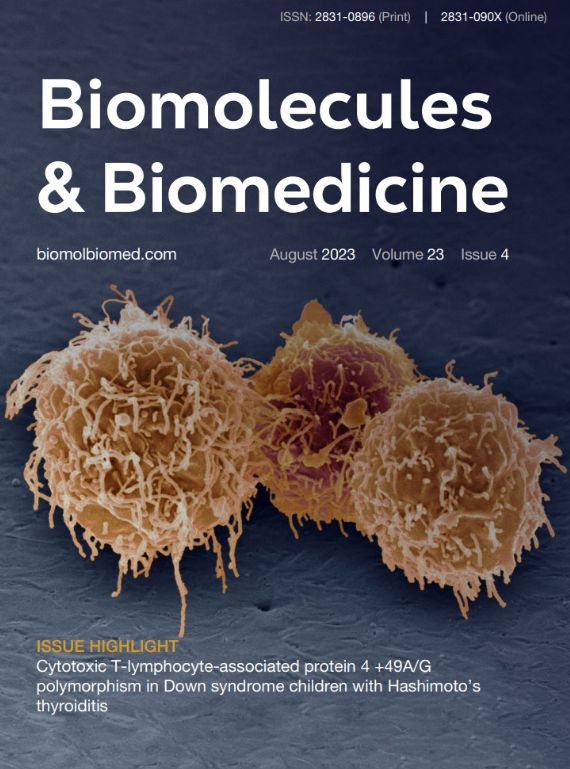Contents
16.03.2023.
Research article
Analysis of cardiac manifestation and treatment of multisystem inflammatory syndrome in children related to SARS-CoV-2
Cardiovascular (CV) manifestations are common (35%–100%) in the multisystem inflammatory syndrome in children. Our study aimed to analyze treatment impact and CV involvement in patients with multisystem inflammatory syndrome in children. The retrospective cohort included 81 patients treated between April 2020 and December 2021 (9.3 ± 4.6 years). Elevated cardiac troponin I and pro-B-type natriuretic peptide were observed in 34.2% and 88.5% of patients, respectively. Myocardial dysfunction was observed in 50.6%. Children older than 10 years had a 4-fold increased risk of myocardial dysfunction (odds ratio [OR] 3.6, 95% confidence interval [CI] 1.4–8.9; p ═ 0.006). A moderate negative correlation was proved between left ventricular ejection fraction and C-reactive protein (rr ═ −0.48; p < 0.001). More than one-fifth of the patients presented with shock. Coronary artery dilatation was observed in 6.2% of patients. Mild pericardial effusion was detected in 27.1% of children. On standard electrocardiogram, 52.6% of children had negative T waves in the inferior and/or precordial leads; transient QTc prolongation was registered in 43% of patients. Treatment failure was observed in 19 patients. Patients initially treated with intravenous immunoglobulins had 10-fold higher chances for treatment failure than patients treated with corticosteroids (OR 10.6, 95% CI 3.18–35.35; p < 0.001). CV manifestations were observed in more than half of the patients, with acute myocardial dysfunction being the most common, especially in children older than 10 years. We established a negative association between the degree of elevation of inflammatory markers and left ventricular ejection fraction. Patients treated with intravenous immunoglobulins who had CV manifestations had treatment failures more frequently than patients treated with corticosteroids.
Stasa Krasic, Sanja Ninic, Sergej Prijic, Sasa Popovic, Srdjan Pasic, Gordana Petrovic, Boris Zec, Snezana Ristic, Dejan Nesic, Luka Nikolic, Vladislav Vukomanovic
16.03.2023.
Research article
Intensity-modulated radiation therapy for elderly patients with esophageal cancer: Our experience
The aim of this study was to discuss the treatment mode of radical radiotherapy (RT) for elderly patients with esophageal cancer (EC). The clinical data of 136 elderly patients (≥60 years old) with EC who received radical intensity-modulated RT in The Second Affiliated Hospital of Xi’an Jiaotong University from January 2015 to December 2019 were retrospectively analyzed. Cox risk model was used for multivariate prognostic analysis, and Kaplan–Meier method was used to calculate progression free survival (PFS) and overall survival (OS). Cox regression analysis showed that ECOG score, basic diseases, T stage, radiation dose, radiation injury, and chemotherapy were the prognostic factors of elderly patients. The median OS of the RT group, concurrent chemoradiotherapy group, and sequential chemoradiotherapy group were 17, 41, and 10 months (p ═ 0.009), respectively. The 3-year OS and PFS of concurrent intravenous chemotherapy and oral chemotherapy were 50% and 42.9%, and 34.1% and 28.6% (p ═ 0.641, p ═ 0.702), respectively. The median OS of involved field irradiation and elective nodal irradiation (ENI) were 23 and 24 months (p ═ 0.219) and the local recurrence rate were 59.8% and 43.2% (p ═ 0.069), respectively, but the incidence and mortality of radiation pneumonia and esophagitis in ENI were higher. The 3-year OS and PFS of the low-dose group (≤60 Gy) and the high-dose group (>60 Gy) were 19.1% and 40.4%, and 14.9% and 29.2% (p ═ 0.012, p ═ 0.049), respectively. In conclusion, for elderly patients with inoperable EC, radical chemoradiotherapy should be considered a preferable selection. Among them, oral drugs and high-dose involved field irradiation exhibited better curative effects and safety.
Dan Li, Xiaoxiao Liu, Yuchen Wang, Yingying Jin, Fang Li, Hongbing Ma
16.03.2023.
Research article
Clinical features and outcomes of fusion gene defined adult Ph-negative B-cell precursor acute lymphoblastic leukemia patients: A single institutional report
More clinical studies are needed to clarify the risk stratification by the integration of all fusion genes in adult B-cell precursor acute lymphoblastic leukemia (BCP-ALL). A total of 320 consecutive adult Ph-negative BCP-ALL patients who had been tested classical fusions (KMT2A rearrangement and TCF3-PBX1) at diagnosis were further retrospectively screened novel fusion genes (Ph-like, ZNF384, and MEF2D fusions) by multiplex real-time quantitative PCR (RQ-PCR). Classical fusions were identified in 12.5% of patients, while 4.4%, 17.2%, and 3.8% of patients were identified Ph-like, ZNF384, and MEF2D fusions, respectively. 1-course CR rate, relapse-free survival (RFS), and overall survival (OS) rates tended to show or showed statistically significant differences among fusion-defined subgroups (P ═ 0.084, <0.001, and 0.0093, respectively). Based on individual outcomes, patients with KMT2A rearrangement, TCF3-PBX1, Ph-like, and MEF2D fusions were classified into fusion-defined high-risk group (n ═ 66, 20.6%). High-risk group had significantly lower 3-year RFS and 3-year OS rates than standard-risk group (P < 0.001 and ═ 0.0022) and was an independent adverse prognostic factor for RFS in the entire cohort (P < 0.001). In conclusion, the spectrum of fusion genes in the current Chinese cohort was distinct from that in reports from western countries. Detection of fusion genes improved risk stratification in adult Ph-negative BCP-ALL patients.
Kai Sun, Jun Wang, Wen-Min Chen, Nan Xu, Ling-Yu Long, Xu Wang, Hao Jiang, Qian Jiang, Xiao-Jun Huang, Ya-Zhen Qin
16.03.2023.
Research article
Development and validation of radiomics machine learning model based on contrast-enhanced computed tomography to predict axillary lymph node metastasis in breast cancer
Preoperative identification of axillary lymph node metastasis can play an important role in treatment selection strategy and prognosis evaluation. This study aimed to establish a clinical nomogram based on lymph node images to predict lymph node metastasis in breast cancer patients. A total of 193 patients with non-specific invasive breast cancer were divided into training (n ═ 135) and validation set (n ═ 58). Radiomics features were extracted from lymph node images instead of tumor region, and the least absolute shrinkage and selection operator logistic algorithm was used to select the extracted features and generate radiomics score. Then, the important clinical factors and radiomics score were integrated into a nomogram. A receiver operating characteristic curve was used to evaluate the nomogram, and the clinical benefit of using the nomogram was evaluated by decision curve analysis. We found that clinical N stage and radiomics score were independent clinical predictors. Besides, the nomogram accurately predicted axillary lymph node metastasis, yielding an area under the receiver operating characteristic curve of 0.95 (95% confidence interval 0.93–0.98) in the validation set, indicating satisfactory calibration. Decision curve analysis confirmed that the nomogram had higher clinical utility than clinical N stage or radiomics score alone. Overall, the nomogram based on radiomics features and clinical factors can help radiologists to predict axillary lymph node metastasis preoperatively and provide valuable information for individual treatment.
Jieqiu Zhang, Gaofei Cao, Haowen Pang, Jin Li, Xiaopeng Yao
16.03.2023.
Research article
Assessment of clinical utility and predictive potential of pre-chemotherapy soluble urokinase plasminogen activator receptor: Observational single center study
Alteration of urokinase plasminogen activator receptor (uPAR) in neoplasms is a pre-requisite for invasiveness and metastatic ability. In the present study, we aimed to evaluate the relationship of pre-chemotherapy soluble uPAR (suPAR) with the odds for metastasis, lack of disease control, and its predictive ability for progression-free survival (PFS). Baseline plasma suPAR levels were measured by ELISA in 89 patients with various cancers prior to initiation of systemic treatment. Patients were followed prospectively until metastatic progression or death. TCGA Pan-Cancer dataset was mined for available RNAseq expression data of the PLAUR gene in patients with breast, colon, and lung cancer, and the relevant genomic and clinical data were extracted for further analysis. Pre-chemotherapy suPAR levels were significantly associated with white blood cell counts and fibrinogen and were significantly elevated both in patients with metastatic disease and in patients with progression. Increasing suPAR was significantly associated with odds for progression in the prespecified multivariate analysis (odds ratio 2.47, 95% confidence interval 1.3–5.11). In univariate Cox regression, suPAR was predictive of shortened PFS (hazard ratio 1.065, 95% confidence interval 1.002–1.13; p = 0.041). There was a trend toward shortened PFS in patients with higher baseline suPAR levels (cutoff 8.1 ng/mL). In the TCGA lung cancer cohort, PLAUR mRNA expression was significantly associated with shortened PFS in both univariate and multivariate analyses. High PLAUR gene expression conferred significant survival disadvantage only in patients with colon and lung cancer. SuPAR may bear predictive potential for adverse outcomes in cancer, but its utility as a biomarker seems to be more pronounced in cancers with associated inflammatory state.
Elina Beleva, Snezhana Stoencheva, Tanya Deneva, Ivanka Nenova, Zhanet Grudeva-Popova
16.03.2023.
Research article
Efficacy and safety of PEG-rhG-CSF in preventing chemoradiotherapy-induced neutropenia in patients with locally advanced cervical cancer
The standard of care for locally advanced cervical cancer is concurrent chemoradiotherapy, which is associated with significant toxicity, especially hematologic toxicity. To evaluate the efficacy and safety of pegylated recombinant human granulocyte colony-stimulating factor (PEG-rhG-CSF) in preventing neutropenia during radical chemoradiotherapy for cervical cancer, 40 patients receiving prophylaxis from February 2018 to July 2019 were randomly divided into two arms in a 1:1 ratio. Patients in the study arm (N ═ 21) received PEG-rhG-CSF, while patients in the control arm (N ═ 19) received short-acting rhG-CSF. The primary endpoint was the incidence of grade 3–4 neutropenia, and the secondary endpoints were the incidence of febrile neutropenia, chemotherapy delay, and radiotherapy interruption. In addition, dynamic changes in absolute neutrophil count during radical chemoradiotherapy and adverse events were compared between the two groups. There were 0 and 4 cycles of grade 3–4 neutropenia in the PEG-rhG-CSF and rhG-CSF groups, respectively. The incidence of neutropenia of all grades was lower in patients on PEG-rhG-CSF than that on rhG-CSF [24.05% (19/79) vs. 56.94% (41/72); p < 0.001]. No patient developed neutropenic fever. The lowest values of neutropenia during chemoradiotherapy cycles were 2.73 ± 1.02 and 1.91 ± 0.79 × 10 9/mL in the PEG-rhG-CSF and rhG-CSF groups, respectively (p < 0.001). In the PEG-rhG-CSF and rhG-CSF groups, 0 and 8 (11.11%) cycles of chemotherapy were delayed due to neutropenia, respectively (p ═ 0.01). There was no delay of radiotherapy by more than one week in either group. Prophylactic use of PEG-rhG-CSF during chemoradiotherapy for cervical cancer can effectively prevent neutropenia and associated adverse events. PEG-rhG-CSF may be an effective strategy to provide uninterrupted radical chemoradiotherapy for cervical cancer.
Weiwei Li, Mohan Dong, Shigao Huang, Liu Shi, Hua Yang, Ying Zhang, Jie Gong, Mei Shi, Lichun Wei, Lina Zhao
16.03.2023.
Research article
Deletion of sphingosine kinase 2 attenuates cigarette smoke-mediated chronic obstructive pulmonary disease-like symptoms by reducing lung inflammation
Cigarette smoke (CS) is the leading cause of chronic obstructive pulmonary disease (COPD), which is characterized by chronic bronchial inflammation and emphysema. Growing evidence supports the hypothesis that dysfunctional cystic fibrosis transmembrane conductance regulator (CFTR) is critically involved in the pathogenesis of CS-mediated COPD. However, the underlying mechanism remains unclear. Here, we report that supressed CFTR expression is strongly associated with abnormal phospholipid metabolism and increased pulmonary inflammation. In a CS-exposed mouse model with COPD-like symptoms, we found that pulmonary expression of sphingosine kinase 2 (SphK2) and sphingosine-1-phosphate (S1P) secretion were significantly upregulated. Therefore, we constructed a SphK2 gene knockout (SphK2−/−) mouse. After CS exposure for six months, histological lung section staining showed disorganized alveolar structure, increased pulmonary fibrosis, and emphysema-like symptoms in wild-type (WT) mice, which were less pronounced in SphK2−/− mice. Further, SphK2 deficiency also decreased CS-induced pulmonary inflammation, which was reflected by a remarkable reduction in pulmonary infiltration of CD45+CD11b+ neutrophils subpopulation and low levels of IL-6 and IL-33 in bronchial alveolar lavage fluid. However, treatment with S1P receptor agonist suppressed CFTR expression and increased Nf-κB-p65 expression and its nuclear translocation in CS-exposed SphK2−/− mice, which also aggravated small airways fibrosis and pulmonary inflammation. In contrast, inhibition of S1P signaling with the S1P receptor analogue FTY720 rescued CFTR expression, suppressed Nf-κB-p65 expression and nuclear translocation, and alleviated pulmonary fibrosis and inflammation after CS exposure. Our results demonstrate that SphK2-mediated S1P production plays a crucial role in the pathogenesis of CS-induced COPD-like disease by impairing CFTR activity and promoting pulmonary inflammation and fibrosis.
Yanhui Chen, Yongrong Zhang, Cheng Rao, Jieyun Huang, Qiong Qing
16.03.2023.
Research article
The role of magnetic resonance imaging in the diagnosis and prognosis of dementia
Dementia is a syndrome characterized by multidomain acquired chronic cognitive impairment that has a profound impact on daily life. Neurogenerative diseases such as Alzheimer’s disease or nondegenerative diseases such as vascular dementia are considered to cause dementia. The need for further diagnostic improvement originates from the prevalence of these conditions, especially in developed countries with a predominance of the elderly population. Today, the diagnosis and follow-up of all neurodegenerative diseases cannot be performed without radiological imaging, primarily magnetic resonance imaging (MRI). The introduction of 3T MRI and its modern techniques, such as arterial spin labeling, has enabled better visualization of morphologic changes in dementia. For better diagnosis and follow-up in patients with dementia, various semiquantitative scales have been designed to improve the accuracy of assessment and decrease interobserver variability. Moreover, there is a growing need for MRI in the assessment of novel therapies and their side effects. To better apply MRI findings in the diagnosis of both already developed dementia and its early stages, the aim of this paper is to review the available literature and summarize the specific MRI changes.
Milica Živanović, Aleksandra Aracki Trenkić, Vuk Milošević, Dragan Stojanov, Miroslav Mišić, Milica Radovanović, Vukota Radovanović
16.03.2023.
Research article
Reduced circulating interleukin 35 is associated with enhanced peripheral T cell function in primary biliary cholangitis
Interleukin 35 (IL-35) mediates immunosuppression of T cells in autoimmune diseases. T cells play an important role in primary biliary cholangitis (PBC) with incompletely elucidated pathogenesis. Thus, we aimed to investigate the role of IL-35 regulation on T cells in PBC patients. Fifty-one PBC patients and 28 controls were enrolled in this study. Plasma IL-35 level was measured. Purified peripheral CD4+ and CD8+ T cells were stimulated with exogenous IL-35 to investigate their functional phenotypes. IL-35-treated CD8+ T cells were cultured with human intrahepatic biliary epithelial cell line to determine the cytotoxicity of CD8+ T cells from PBC patients. Plasma IL-35 concentration was lower in PBC patients and negatively correlated with alkaline phosphatase. CD4+ T cells from PBC patients exhibited elevated transcription factor expressions and cytokine secretion, whereas CD8+ T cells produced increased cytotoxic molecules and cytokines. In vitro IL-35 stimulation suppressed the production of IL-17 and IL-22 by CD4+ T cells from PBC patients. CD8+ T cells treated with IL-35 mediated reduced target cell death in the direct contact co-culture system in PBC patients. This process was accompanied by reduced production of cytotoxic molecules and cytokines and increased expressions of immune checkpoint receptors in CD8+ T cells. Reduced circulating IL-35 might be insufficient to suppress T cell function, leading to the immune dysregulation in PBC patients.
Siqi Liu, Qian Zhang, Mengyao Zhang, Xuejing Zhong, Wudong Wang, Lishuang Wang, Zhenjing Jin
16.03.2023.
Research article
Possible mechanism of static progressive stretching combined with extracorporeal shock wave therapy in reducing knee joint contracture in rats based on MAPK/ERK pathway
The study aimed to observe the therapeutic effect of static progressive stretching (SPS) combined with extracorporeal shock wave therapy (ESWT) on extension knee joint contracture in rats and the effect on the mitogen-activated protein kinase (MAPK)/extracellular signal-regulated kinase (ERK) pathway in the development of joint capsule fibrosis. Thirty-six Sprague Dawley rats were randomly divided into blank control group, immobilization model group, natural recovery group, ESWT intervention group, SPS intervention group, and SPS combined with ESWT intervention group. The left knee joints of the rats, except for the control group, were fixed with an external fixation brace for four weeks at full extension to form joint contracture. The therapeutic effect of each intervention was assessed by evaluating total and arthrogenic contracture, the number of total cells and collagen deposition in the anterior joint capsule, the protein levels of TGF-β1, FGF-2, and ERK2 in the anterior joint capsule, the mean optical density of upstream RAS and downstream ERK2 positive expression in the MAPK/ERK pathway. SPS in combination with ESWT was more effective in relieving joint contracture, improving the histopathological changes in the anterior joint capsule, and suppressing the high expression of target proteins and the overactivated MAPK/ERK pathway. The overactivated MAPK/ERK pathway was involved in the formation of extension knee joint contracture in rats. SPS in combination with ESWT was effective in relieving joint contracture and fibrosis of joint capsule. Moreover, the inhibition of the overactivated MAPK/ERK pathway may be the potential molecular mechanism for its therapeutic effect.
Run Zhang, Quan-Bing Zhang, Yun Zhou, Rui Zhang, Feng Wang












